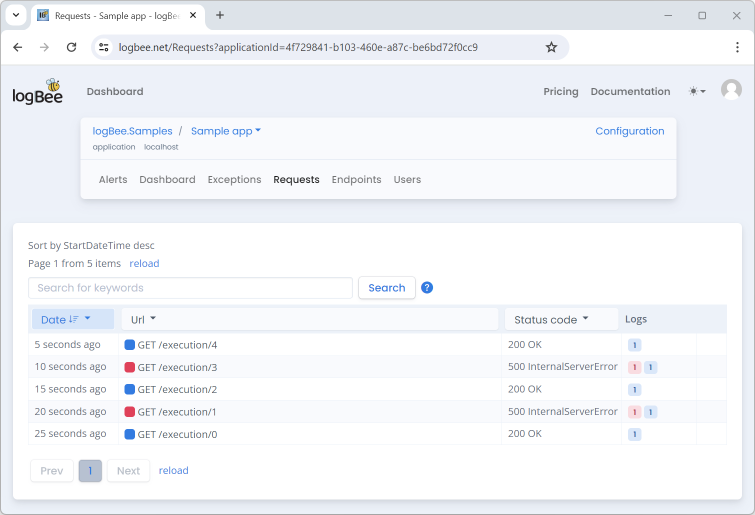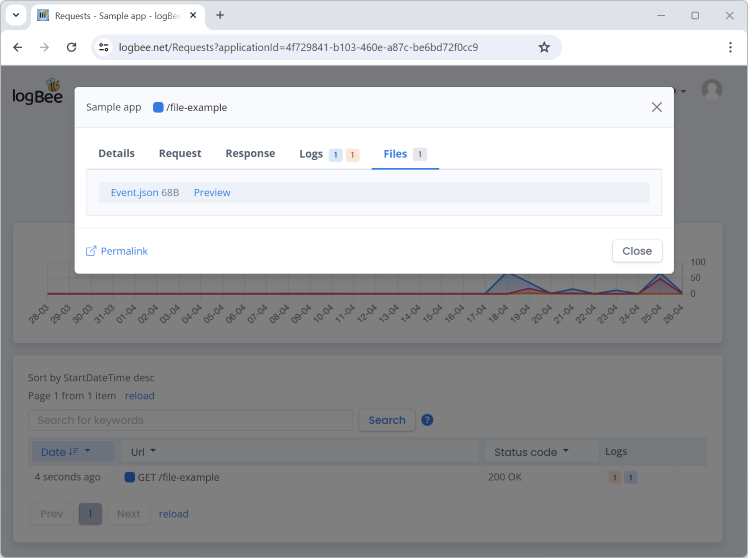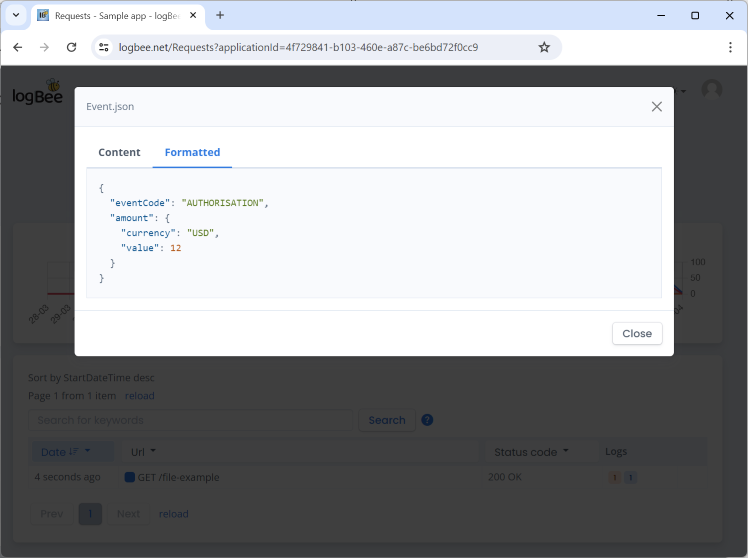Console applications¶
Console applications using Serilog can integrate the Serilog.Sinks.LogBee Sink to write events to logBee.net.
var log = new LoggerConfiguration()
.WriteTo.LogBee(
new LogBeeApiKey("_OrganizationId_", "_ApplicationId_", "https://api.logbee.net")
)
.CreateLogger();
Saving the logs¶
The Serilog.Sinks.LogBee Sink stores all the events in memory and submits them to the logBee endpoint when the Serilog logger is flushed.
For this reason, you always need to call Log.CloseAndFlush() method before the program execution completes.
Log.Logger = new LoggerConfiguration()
.WriteTo.LogBee(new LogBeeApiKey("_OrganizationId_", "_ApplicationId_", "https://api.logbee.net"))
.CreateLogger();
try
{
Log.Information("Hello, {Name}!", name);
}
catch(Exception ex)
{
Log.Error(ex, "Unhandled exception");
}
finally
{
// send the events to logBee.net
Log.CloseAndFlush();
}
Advanced usage¶
logBee.net saves the log events under individual “Requests”.
For console applications, a “Request” can be seen as an individual application execution.
Using a loggerContext, you can configure the properties of the “Requests” generated by the different application executions.
using Serilog.Sinks.LogBee;
namespace Serilog.Sinks.LogBee_ConsoleApp;
class Program
{
static void Main(string[] args)
{
var loggerContext = new NonWebLoggerContext();
Log.Logger = new LoggerConfiguration()
.WriteTo.LogBee(
new LogBeeApiKey("_OrganizationId_", "_ApplicationId_", "https://api.logbee.net"),
loggerContext
)
.CreateLogger();
Foo(loggerContext);
Bar(loggerContext);
}
static void Foo(NonWebLoggerContext loggerContext)
{
loggerContext.Reset("http://application/foo");
Log.Information("Foo execution");
// send the logs to logBee.net
loggerContext.Flush();
}
static void Bar(NonWebLoggerContext loggerContext)
{
loggerContext.Reset("http://application/bar");
Log.Information("Bar execution");
// send the logs to logBee.net
loggerContext.Flush();
}
}

Microsoft.Extensions.Logging¶
The Serilog.Sinks.LogBee Sink works with the logging provider by the .NET Core.
To use the Microsoft.Extensions.Logging framework, you will also need to install the Serilog.Extensions.Hosting NuGet package.
using Microsoft.Extensions.DependencyInjection;
using Microsoft.Extensions.Logging;
using Serilog.Sinks.LogBee;
namespace Serilog.Sinks.LogBee_ConsoleApp;
class Program
{
static void Main(string[] args)
{
var loggerContext = new NonWebLoggerContext();
Log.Logger = new LoggerConfiguration()
.WriteTo.LogBee(
new LogBeeApiKey("_OrganizationId_", "_ApplicationId_", "https://api.logbee.net"),
loggerContext
)
.CreateLogger();
var services = new ServiceCollection();
services.AddLogging((builder) =>
{
builder.AddSerilog();
});
// we inject the loggerContext so we can access it later, if needed
services.AddSingleton(loggerContext);
var serviceProvider = services.BuildServiceProvider();
var logger = serviceProvider.GetRequiredService<ILogger<Program3>>();
logger.LogInformation("Hi there");
Log.CloseAndFlush();
}
}
“Request” properties¶
In console applications where the concept of requests may not apply directly, the NonWebLoggerContext can be used to configure the “HTTP” properties that are saved in logBee.net.
Configuring the “Requests” can be useful for identifying and filtering different application executions in the logBee.net user-interface.
using Serilog.Sinks.LogBee;
namespace Serilog.Sinks.LogBee_ConsoleApp;
class Program
{
static async Task Main(string[] args)
{
var loggerContext = new NonWebLoggerContext();
Log.Logger = new LoggerConfiguration()
.WriteTo.LogBee(
new LogBeeApiKey("_OrganizationId_", "_ApplicationId_", "https://api.logbee.net"),
loggerContext
)
.CreateLogger();
int executionCount = 0;
while (true)
{
loggerContext.Reset(new RequestProperties($"http://application/execution/{executionCount}")
{
Headers = new Dictionary<string, string>
{
{ "key1", "value1" }
}
});
Log.Information("First log message from Serilog");
try
{
// execute some code
if (executionCount % 2 == 1)
throw new Exception("Oops, odd execution error");
}
catch (Exception ex)
{
Log.Error(ex, "Error executing some code");
// if we had an error, we set the "StatusCode" to 500
loggerContext.SetResponseProperties(new ResponseProperties(500));
}
finally
{
// flush the logs to the logBee endpoint
await loggerContext.FlushAsync();
}
await Task.Delay(5000);
executionCount++;
}
}
}

Logging files¶
You can use the loggerContext to save string contents as files.
var loggerContext = new NonWebLoggerContext("/file-example");
Log.Logger = new LoggerConfiguration()
.WriteTo.LogBee(
new LogBeeApiKey("_OrganizationId_", "_ApplicationId_", "https://api.logbee.net"),
loggerContext
)
.CreateLogger();
Log.Information("Info message");
Log.Warning("War message");
loggerContext.LogAsFile(JsonSerializer.Serialize(new
{
eventCode = "AUTHORISATION",
amount = new
{
currency = "USD",
value = 12
}
}), "Event.json");
Log.CloseAndFlush();


For technical support, questions or any feedback, please feel free to send us a message and we will get back to you.